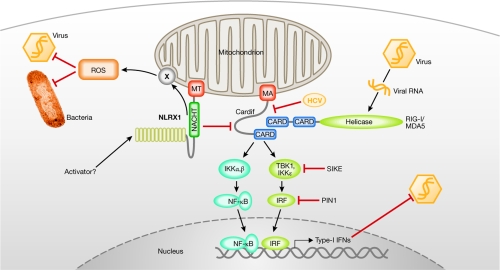Figure 1.
Mitochondria as anti-pathogen platforms. Through its mitochondrial anchor (MA) sequence, Cardif is targeted to the outer membrane of mitochondria, where it orchestrates RLH-dependent antiviral responses through the recruitment of both viral RNA sensors (RIG-I or MDA5) and effector proteins (IKK). Several cellular (SIKE, PIN1) but also viral (for example, the protease of HCV) proteins tightly regulate the antiviral response. NLRX1, another mitochondria-targeted protein (MT), might act as a negative regulator of Cardif signalling, diminishing virally induced Cardif–RLH interactions. However, NLRX1 also promotes ROS production at the mitochondria, which consequently helps to fight bacteria and viruses. How NLRX1 performs these functions, and how it becomes activated, remain unanswered questions. CARD, caspase recruitment domain; HCV, hepatitis C virus; IFN, interferon; IKK, IκB kinase; IRF, interferon regulatory factor; MDA5, melanoma-differentiation-associated protein 5; NLRX1, NOD-like receptor X1; PIN1, peptidylpropyl isomerase 1; RIG-I, retinoic-acid-inducible gene I; ROS, reactive oxygen species; RLH, RIG-like helicase; SIKE, supressor of IKKɛ; TBK, TANK-binding kinase.

